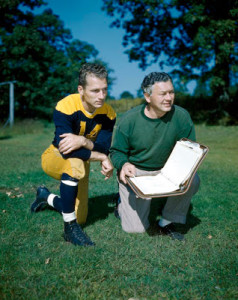by Chase Stuart
on March 6, 2013

Don Hutson is down with era adjustments.
I’ve written several posts about
how to grade wide receivers and did a three-part series on
one ranking system two weeks ago. Grading wide receivers requires one to adjust for era, but there are many different ways to do that.
Calvin Johnson caught 122 passes last year for 1,964 yards and five touchdowns. In 1973, Harold Carmichael had 67 receptions, 1,116 yards and nine scores. Which season was better? You might be inclined to think Johnson’s season was much better regardless of era, but both receivers led their respective leagues in both receptions and receiving yards. But let’s think about it another way.
In 1973, all the players on the 26 teams in the NFL combined for a total of 4,603 catches and 58,009 receiving yards. That means Carmichael was responsible for 1.46% of all receptions and 1.92% of all receiving yards. Of course, with only 26 teams, we need to multiply those numbers by 26/32 make for an apples-to-apples comparison of the modern environment. If we want to transport Carmichael into 2012, that means he needs to be credited with 1.18% of all receptions and 1.56% of all receiving yards accumulated last year. That would give him 128 catches and 1,970 receiving yards, and thanks to recording 1.93% of all receiving touchdowns in 2012, 14.6 touchdowns.
This analysis is actually unfair to active players, as there are more three-, four-, and five-wide receiver sets than ever before. Elroy Hirsch gained 1,495 receiving yards in 12 games — an outstanding rate of production in any era — but that translates to an absurd 2,667 receiving yards in 2012. In Don Hutson’s magical 1942 season, after multiplying by 10/32, he gained 2.3% of the league’s receptions, 2.8% of the receiving yards, and 4.9% of the touchdowns — for a 254/3501/37 stat line.
[continue reading…]
Tagged as:
Calvin Johnson,
Harold Carmichael,
Ranking Systems,
WR Project,
WR Ranking Systems
{ }
by Chase Stuart
on February 20, 2013
On Monday, I explained my methodology for ranking every wide receiver in football history, and yesterday, I presented a list of the best single seasons of all time. Today the career list of the top 150 wide receivers. As usual, I implemented a 100/95/90 formula, giving a player credit for 100% of his production in his best season, 95% of his value in his second-best season, 90% in his third year, and so on. The table below is fully sortable and lists the first and last year each person played wide receiver ; you can use the search feature to find the best receiver to ever play for each team (for example, typing ‘ram’ for the Rams ‘clt’ for the Colts.)
[continue reading…]
Tagged as:
GOAT,
Ranking Systems,
WR Project,
WR Ranking Systems
{ }
by Chase Stuart
on February 19, 2013
Yesterday, I explained my methodology for ranking every wide receiver in football history. Today I’m going to present a list of single-season leaders, which presents some problems.
I think the method I described yesterday does a good job adjusting for era, as receivers are only given credit for their yards above the baseline, which is different each season. But there are some other complicating factors unique to football. Seasons have had varying lengths: a receiver who plays 12 games in a 12-game season can’t be penalized the way you would penalize a receiver who only plays in 12 games now. Since older receivers are generally at a disadvantage for many reasons, I decided to simply pro-rate the value for all non-16 game seasons as if it was a 16-game season. However, I have also included downward adjustments for players in other leagues and during World War II.
The table below lists the top 200 wide receiver seasons of all-time.
[continue reading…]
Tagged as:
GOAT,
Ranking Systems,
WR Project,
WR Ranking Systems
{ }
by Chase Stuart
on February 18, 2013

We know how this story will end.
Regular readers know that one of my projects this off-season is to come up with a better way to grade wide receivers. I first attempted to
rank every wide receiver four years ago. That study, which I will reproduce this week, has some positives and negatives. My goal is to eventually come up with four or five different ranking systems, so consider the series this week to be the first of several ranking systems to come.
The first step in this system is to combine the three main stats — receptions, receiving yards and receiving touchdowns — into one stat: Adjusted Catch Yards. We know that a passing touchdown is worth about 20 yards, so I’m crediting a receiver with 20 yards for every touchdown reception. Next, we need to decide on an appropriate bonus for each reception.
We want to give receivers credit for receptions because, all else being equal, a receiver with more receptions is providing more value because he’s likely generating more first downs. I looked at all receivers over a 12-year period who picked up at least 30 receiving first downs. I then used the number of receptions and receiving yards those players had as inputs, and performed a regression to estimate how many first downs should be expected. The best-fit formula was:
[continue reading…]
Tagged as:
GOAT,
Ranking Systems,
WR Project,
WR Ranking Systems
{ }


